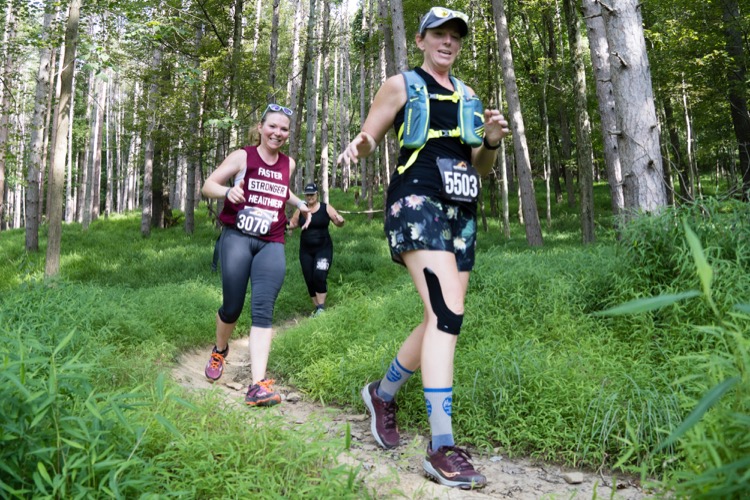“More women will hit the trails when they see themselves represented on the trails.” These are the words of Jubilee Paige, race director (RD) for the iconic Black Canyon 100K in Phoenix, Arizona. At the start of this year’s race, Paige shouted, “Get to the front, ladies! This is 2022!”
Women tend to tuck back at the start of a race, while men gravitate to the front. This year’s Black Canyon was no different. As Paige pointed out, “Visibility matters.” Starting line photos are often used as marketing material. When void of females, the images are less likely to attract women registrants.
As a participant in this year’s Black Canyon 100K, I did my part by pushing forward among a packed starting corral of mostly men. The first five miles are relatively open with plenty of room to pass. With that in mind, the front line didn’t need to be relegated to just the 6-minute milers. And in my experience, one’s positioning at the start of an ultra is often a function of confidence rather than a meaningful strategy for winning a race. (This theory does not apply to the 5k distance.)
It’s worth noting that the combined finish rate among women for the 2022 Black Canyon 100K and 60K was 72%, while their male counterparts came in at 65%. Not only are women excelling at finishing these races, they continue to close the speed gap. Camille Herron’s outright win of the Jackpot Ultra and world-record accomplishment for the 100-miler (a mind-blowing 7:37 minute/mile for 100 miles) is a testament to women’s well-deserved place in the sport of ultrarunning.
Two years ago, I competed in Ohio’s Backyard Ultra (OBU). My entry into a full field was brought about through special consideration from RD Michael Owen. With the specific intent of balancing the field of runners, Owen set aside entries for women, in addition to some other considerations. “I believe there are still a lot of cultural and societal norms that lead to less participation of women than men in ultrarunning,” said Owen. “It’s crazy to think that it was not until 1972 that the Boston Marathon allowed women to participate in the event, and that was with reluctance.” Owen’s strategy has led to a marked increase in female participation in his consistently sold-out backyard ultra.
In three short years, OBU has gone from 17% women (2020) to 30% (2022). Plus, the 2021 OBU race had 55-year-old Jennifer Russo running for 54 solid hours while logging 225 miles.
With heightened visibility and more resources, large events have the ability to affect change at a faster rate. In looking at the renowned Western States Endurance Run, a commitment to inclusion marks another step forward. “We have a DEI committee and have looked at this issue for a while. Our first steps were to adopt our pregnancy policies,” said Diane Fitzpatrick, president of the Western States board of directors. Fitzpatrick is referring to a policy adopted in 2018 that affords pregnant women the option of deferring their entry for up to three years. Other strategic steps include equal start line space, (no need to throw elbows), equal media coverage and a shift in leadership to include more females in key roles. Fitzpatrick’s appointment as president of the board is a prime example.
“It seems like our efforts on the elite side are starting to pay off,” said Fitzpatrick. Pay off, indeed. The 2021 Western States race yielded three women in the top 10 and churned out an impressive 50-50 finisher split (male to female) in the top 30.
Smaller ultras with less demand and no waitlists are not always able to employ the same tactics as the iconic races. As a board member of a local nonprofit which hosts an annual 50-miler (Baker Trail UltraChallenge), I am keenly aware of the difficult nature of increasing female participation. Determined to buck the 80/20 ratio (men to women) that we’ve had for the past decade, our Diversity, Equity and Inclusion committee has worked to secure donations earmarked for gender equity. With these funds, we are setting aside complimentary entries for women. In addition, we’re hosting a series of “info sessions,” covering all aspects of the race with an eye on instilling confidence, quelling fears and ultimately, motivating women to register.
Some other initiatives we are employing that can work for smaller races include promotion of training runs, free and open to the public. These runs give potential participants a chance to experience the course and overcome the typical reluctance of first-timers. Growing the sport for all genders should be our goal. Ultimately, we are aiming for our race to hit a consistent “sold out” status by 2025. It should be noted that the high-demand ultras, with long waitlists, have the unique ability to achieve gender parity sooner.
Women now participate and perform at unprecedented levels. This should be enough to inspire race directors to continue working toward the noble goal of gender parity across all levels of ultrarunning.

